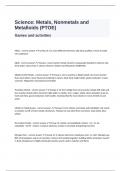Metals and nonmetals - Samenvattingen, Aantekeningen en Examens
Op zoek naar een samenvatting over Metals and nonmetals? Op deze pagina vind je 518 samenvattingen over Metals and nonmetals.
Pagina 3 van de 518 resultaten
Sorteer op


-
CSP1501 Assignment 3 (DETAILED ANSWERS) 2024 - DISTINCTION GUARANTEED
- Tentamen (uitwerkingen) • 15 pagina's • 2024
-
- €2,69
- + meer info
CSP1501 Assignment 3 (DETAILED ANSWERS) 2024 - DISTINCTION GUARANTEED Answers, guidelines, workings and references ................... QUESTION 1 [35] 1. Two high school leaners came to you confused about the physical properties of metals and nonmetals, in a table form contrast the differences between the physical properties of metals and nonmetals (10) 2. Periodic table is the organized array of all the chemical elements in order of increasing atomic number, that is the total number of proton...

-
TEST BANK for CHEMISTRY: The Central Science 12th Edition Brown, LeMay, Bursten Murphy Woodward ISBN 9780321696724 Chapter 1-24 | Complete Guide A+
- Tentamen (uitwerkingen) • 802 pagina's • 2023
-
- €19,49
- + meer info
CHEMISTRY: The Central Science 12TH EDITION Brown, LeMay, Bursten Murphy Woodward TEST BANK ISBN-978-4 This is a Test Bank (Study Questions & Complete Answers for all chapters of the book) to help you study for your Tests. Test banks can give you the tools you need to help you study better. Table of Contents 1 Introduction: Matter and Measurement 2 Atoms, Molecules, and Ions 3 Stoichiometry: Calculations with Chemical Formulas and Equations 4 Reactions in Aqueous Solution 5 Thermochemistry 6 Ele...
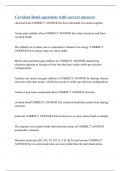
-
Covalent Bond questions with correct answers
- Tentamen (uitwerkingen) • 17 pagina's • 2023
-
- €14,61
- + meer info
chemical bond CORRECT ANSWER the force that holds two atoms together Atoms gain stability when CORRECT ANSWER they share electrons and form covalent bonds. The stability of an atom, ion or compound is related to its energy: CORRECT ANSWER lower energy states are more stable Metals and nonmetals gain stability by CORRECT ANSWER transferring electrons (gaining or losing) to form ions that have stable noble-gas electron configurations. Another way atoms can gain stability is CORRECT ANS...
Science: Metals, Nonmetals and Metalloids (PTOE) Games and activities question n answers
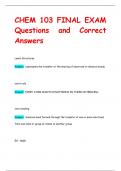
-
CHEM 103 FINAL EXAM Questions and Correct Answers
- Tentamen (uitwerkingen) • 71 pagina's • 2024
-
Ook in voordeelbundel
-
- €12,66
- + meer info
Lewis Structures Answer: represents the transfer or the sharing of electrons in chemical bonds octet rule Answer: EVERY ATOM WANTS 8 ELECTRONS IN THEIR OUTERSHELL ionic bonding Answer: chemical bond formed through the transfer of one or more electrons from one atom or group of atoms to another group EX : NaBr metals Answer: give nonmetals Answer: take oxidation number Answer: the superscript indicating the charge on an ion ion Answer: atom with either positive or negative charge...
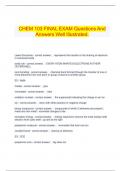
-
CHEM 103 FINAL EXAM Questions And Answers Well Illustrated.
- Tentamen (uitwerkingen) • 21 pagina's • 2024
-
- €12,18
- + meer info
CHEM 103 FINAL EXAM Questions And Answers Well Illustrated. Lewis Structures - correct answer. represents the transfer or the sharing of electrons in chemical bonds octet rule - correct answer. EVERY ATOM WANTS 8 ELECTRONS IN THEIR OUTERSHELL ionic bonding - correct answer. chemical bond formed through the transfer of one or more electrons from one atom or group of atoms to another group EX : NaBr metals - correct answer. give nonmetals - correct answer. ...
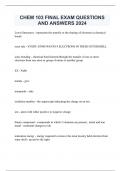
-
CHEM 103 FINAL EXAM QUESTIONS AND ANSWERS 2024
- Tentamen (uitwerkingen) • 35 pagina's • 2024
-
Ook in voordeelbundel
-
- €13,15
- + meer info
Lewis Structures - represents the transfer or the sharing of electrons in chemical bonds octet rule - EVERY ATOM WANTS 8 ELECTRONS IN THEIR OUTERSHELL ionic bonding - chemical bond formed through the transfer of one or more electrons from one atom or group of atoms to another group EX : NaBr metals - give nonmetals - take oxidation number - the superscript indicating the charge on an ion ion - atom with either positive or negative charge binary compound - compounds in wh...

-
GCSE EDEXCEL TRIPLE SCIENCE CHEMISTRY PAPER 2 2024 QUESTION PAPER WITH QUESTIONS AND CORRCT ANSWERS GRADED A+
- Tentamen (uitwerkingen) • 43 pagina's • 2024
-
Ook in voordeelbundel
-
- €17,54
- + meer info
GCSE EDEXCEL TRIPLE SCIENCE CHEMISTRY PAPER 2 2024 QUESTION PAPER WITH QUESTIONS AND CORRCT ANSWERS GRADED A+ What is in the nucleus? - CORRECT ANSWER-Protons and neutrons What is relative atomic mass? - CORRECT ANSWER-Relative atomic mass is an average mass taking into account the different masses and abundances of all the isotopes that make up the element How do you calculate the relative atomic mass? - CORRECT ANSWER-Sum of (isotope abundance x isotope mass number) / sum of abundan...
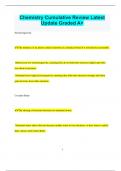
-
Chemistry Cumulative Review Latest Update Graded A+
- Tentamen (uitwerkingen) • 7 pagina's • 2024
-
Ook in voordeelbundel
-
- €9,74
- + meer info
Chemistry Cumulative Review Latest Update Graded A+ Electronegativity The tendency of an atom to attract electrons in a chemical bond. It is not directly measurable. Metals have low electronegativity, meaning they do not hold onto electrons tightly and often lose them in reactions. Nonmetals have high electronegativity, meaning they hold onto electrons strongly and often gain electrons from other elements. Covalent Bond The sharing of electrons between two nonmetal atoms. ...

-
Test Bank for Chemistry: The Central Science 12th Edition Brown, LeMay, Bursten Murphy Woodward
- Tentamen (uitwerkingen) • 802 pagina's • 2023
-
- €19,49
- + meer info
Test Bank for Chemistry: The Central Science 12th Edition Brown, LeMay, Bursten Murphy Woodward. Table of Contents 1 Introduction: Matter and Measurement 2 Atoms, Molecules, and Ions 3 Stoichiometry: Calculations with Chemical Formulas and Equations 4 Reactions in Aqueous Solution 5 Thermochemistry 6 Electronic Structure of Atoms 7 Periodic Properties of the Elements 8 Basic Concepts of Chemical Bonding 9 Molecular Geometry and Bonding Theories 10 Gases 11 Liquids and Intermolecular Forces 12 So...

Die samenvatting die je net hebt gekocht, heeft iemand erg blij gemaakt. Ook wekelijks uitbetaald krijgen? Verkoop je studiedocumenten op Stuvia! Ontdek alles over verdienen op Stuvia

